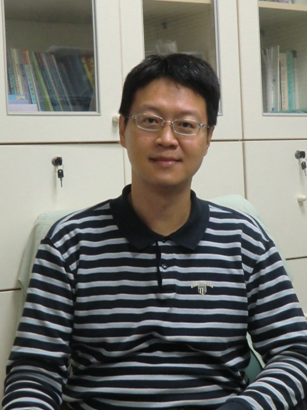Shao-Jung Wu
|
|
Shao-Jung Wu Associate Professor |
|
Phone: (02) 2908-9899 ext.4626 Fax:(02) 2908-3072 Email: sjwu@mail.mcut.edu.tw Office: 217 |
|
|
Lab Info |
|
|
Nonocomposite Laboratory (02) 2908-9899 ext.4604 Location:301-3 |
n Education Background(學歷背景)
B.S. National Central University
M.S. National Central University
Ph. D. National Central University
n Research Topic (研究方向)
Polymer materials and composites (範例)
A novel and straightforward synthetic technique for the preparation of porous chitosan/reduced graphene oxide (CS/r-GO) composites is desirable. The aim of this study was to develop porous chitosan/r-GO composites, and the r-GO was dispersed in chitosan matrix, and was thus able to maintain appropriate dispersion and stability, which greatly improves their applicability. The present study explores the adsorption capacities, kinetics and thermodynamics of Cu(II) ions from aqueous solution onto fabricated composites. Cu(II) ions adsorbed on composites were reduced by chemical treatment to synthesize the copper nanoparticles/chitosan/r-GO composites. Under near-infrared irradiation, the organic compound could be reduced in the presence of fabricated composites, and the results for the application of porous copper nanoparticles/chitosan/r-GO composites are evaluated in organic reactions.
This study used an in-liquid curing method by the ionotropic crosslinking with nontoxic multicarboxylic acid to synthesize the chitosan-carboxylic acid beads, which are used to fabricate magnetic chitosan beads. The magnetic iron oxide nanoparticles (MNPs) were dispersed on chitosan-carboxylic acid beads, and were thus able to maintain appropriate dispersion and stability, which greatly improves their applicability. The present study aims to explore the adsorption capacities, kinetics and thermodynamics of metal ions from aqueous solution onto fabricated magnetic gelled beads. The influence of initial pH of Cu(II) ions solution and initial concentration of metal ions solution on the uptake of Cu(II) ions were also studied.
The use of the chitosan-coated silver nanoparticles as a heavy-metal ion sensors, its preparation and characterization will be examined. The chitosan enables attachment of the polymer to the negatively charged metal nanoparticle surfaces through electrostatic interactions. Chitosan could also provide sufficient steric hindrance ensuring stability of the colloid and functionalize the metal nanoparticles for use as sensors. A surface plasmon peak is observed at around 400 nm, characteristic of the Ag nanoparticles. Fluorescence emission maxima at 485 and 542 nm are observed for excitations at 400 nm. The resulting chitosan-stabilized metal nanoparticles will be characterized by transmission electron microscopy (TEM), UV-Vis spectroscopy and fluorescence spectrometry. A comparison of the optical absorption spectra and fluorescence effect of the colloidal suspension before and after exposure to heavy-metal ions will be discussed.
n Recent 5-years Research Topic(近五年研究計畫)
1. [Synthesis and application of magnetic and nontoxic chitosan-multicarboxylic acid gel beads], sponsored by Ministry of Science and Technology, MOST 100-2221-E-131-013, 8/01/2011-7/31/2012.
2. [PLA and plant fiber alloy method], sponsored by AGT Green Technology Co., Ltd., O01102S036, 9/01/2013-8/31/2015.
3. [Preparation and application of porous chitosan/reduced graphene oxide composites], sponsored by Ministry of Science and Technology, MOST 104-2221-E-131-022, 8/01/2015-7/31/2016.

